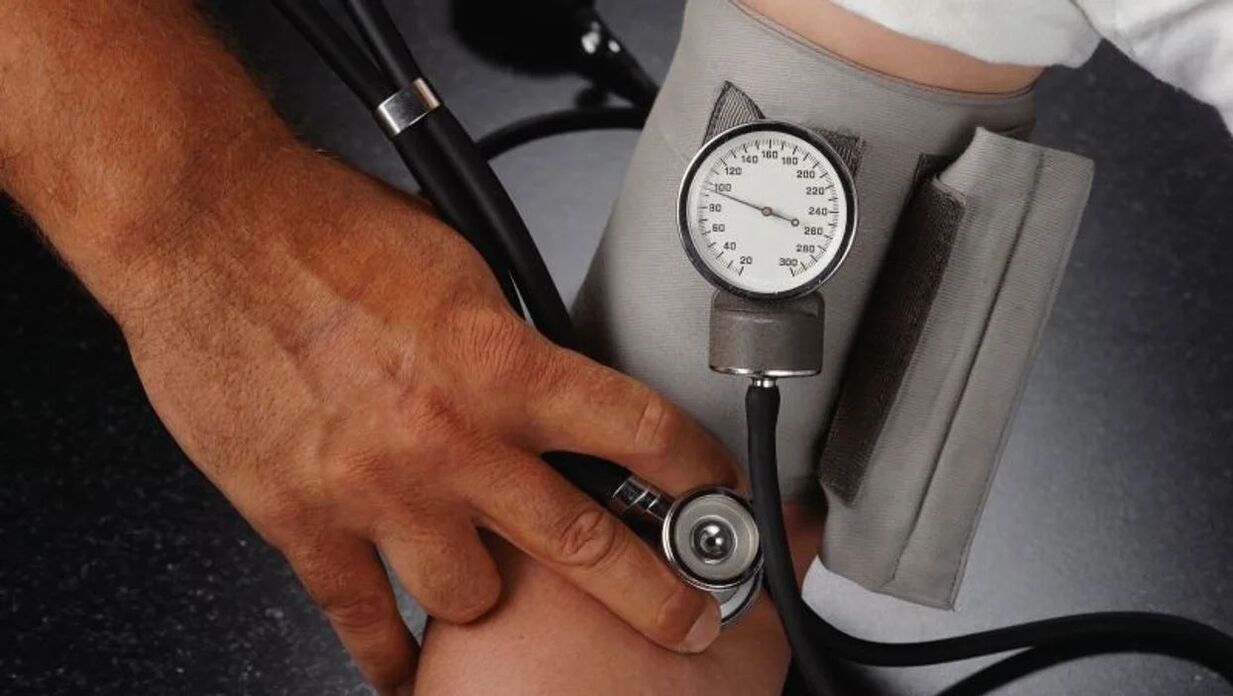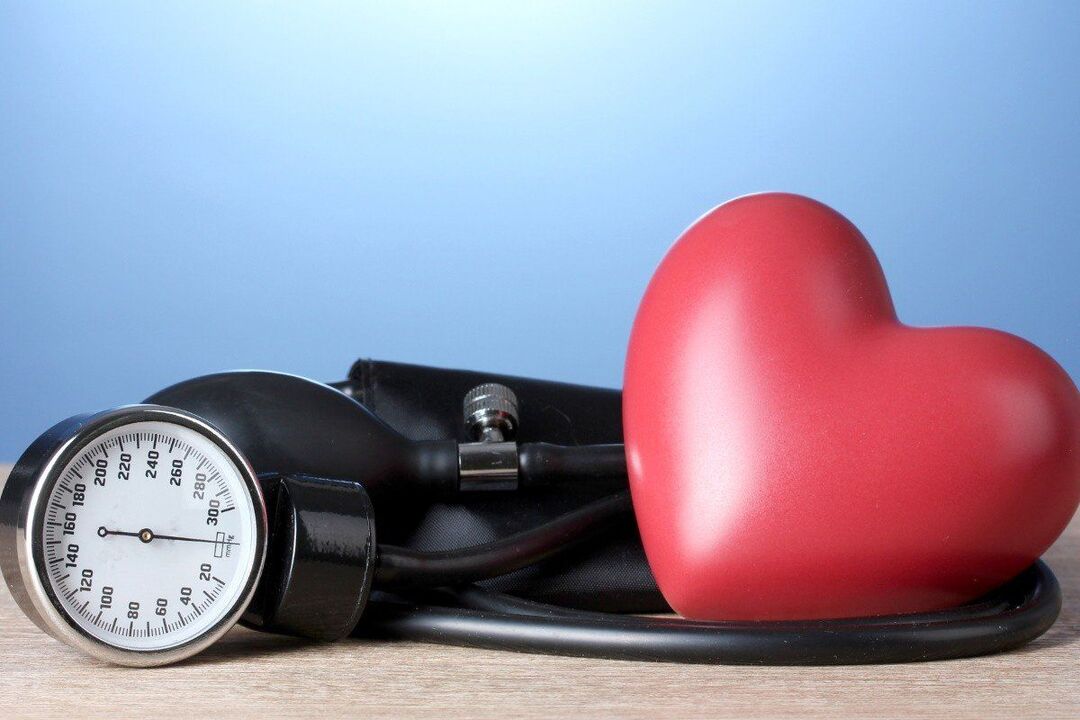A person lives as long as his heart beats. The heart is a "pump" that ensures blood circulation in the vessels. In this regard, there is such a thing as blood pressure. Abbreviated as AD. Any deviation from normal blood pressure is fatal.
It specializes in the diagnosis and treatment of respiratory diseases and allergies, has methods for testing the functioning of external breathing, allergy testing with allergens, autohemotherapy, specific and non-specific immunotherapy.
The risk of developing high blood pressure
The risk of developing high blood pressure, or high blood pressure - high blood pressure - depends on many factors. Accordingly, the more there are, the greater the probability that a person will be hypertensive.
Risk factors for the development of high blood pressure:
- hereditary tendency. People with high blood pressure have a higher risk of the disease among first-degree relatives: father, mother, grandmothers, grandfathers, brothers. The more close relatives with high blood pressure, the greater the risk;
- Age over 35 years;
- stress (stress hypertension) and mental stress. The stress hormone adrenaline increases the heart rate. It immediately constricts blood vessels;
- taking certain medications, such as oral contraceptives and various dietary supplements (iatrogenic hypertension);
- bad habits: smoking or drinking alcohol. The components of tobacco provoke the spasm of the blood vessels - the involuntary contraction of the walls. This narrows the blood flow;
- atherosclerosis - blockage of blood vessels with plaques. Total cholesterol must not exceed 6. 5 mmol/l blood;
- kidney failure (nephrogenic hypertension);
- endocrinopathy of the adrenal glands, thyroid gland or pituitary gland;
- excessive salt in food. Table salt causes arterial spasm and fluid retention in the body;
- inaction. Physical inactivity is associated with a slow metabolism - metabolism - and gradually weakens the body as a whole;
- overweight. Every extra kilogram increases blood pressure by 2 millimeters of mercury - mm Hg;
- sudden change in weather;
- chronic lack of sleep and other "provocateurs".
Most risk factors for developing high blood pressure are closely related. Thus, heavy smokers develop arteriosclerotic plaques in most cases, and physically inactive and malnourished people quickly gain excess weight. Such a combination of factors significantly increases the risk of pathological abnormalities of the heart.
Depending on the combination of the above factors and their degree of manifestation, as well as the likelihood of cardiovascular complications, there are 4 risks of developing arterial hypertension in the next decade:
- low (the risk is less than 15%);
- average (15-20%);
- high (more than 20%);
- very high (more than 30%).
Risk factors for the appearance of arterial hypertension are also divided into 2 types based on the possibility of their elimination: correctable (correctable) and not. For example, someone may quit smoking but not be able to change their ancestry. The degree of risk is summarized by several indicators. A patient with stage 1 hypertension who begins to abuse alcohol significantly increases the chance of developing complications.
Hypertension is very treatable. Here, a lot depends on the timely diagnosis of the disease, the patient's perseverance and his willingness to radically change his lifestyle.
Hypertension 1st degree

Arterial hypertension can be primary, i. e. develops independently, and can be secondary - a complication of another disease. In the latter case, the treatment is carried out comprehensively, because it is not only necessary to normalize the pressure, but also to cure the cause of the accompanying disease.
A blood pressure of 120/80 mm Hg is considered normal. This is the "ideal" value, as they say, for astronauts. 120 is the so-called upper blood pressure or systolic pressure (when the walls of the heart muscle are maximally contracted). And 80 is the lower indicator or the so-called diastolic pressure (when they are maximally relaxed). Accordingly, thehypertension is divided into systolic, diastolic and mixed (systolic-diastolic) groups, depending on whether the upper or lower indicators exceed the threshold.
When the lumen of blood flow narrows, the heart spends more effort pushing blood into the vessels, wears out faster and begins to work intermittently. An increase in the heart rate - the heart rate - negatively affects the functioning of the entire body. The air and nutrients in the blood do not have time to enter the cells.
Like any disease, high blood pressure will progress if left untreated. The appearance of the first hypertensive symptoms is preceded by a prehypertensive state - prehypertension.
The severity of the disease depends on the stage of development of the disease:
- "soft" or light;
- moderate or borderline;
- very severe or isolated systole.
By the way, stage 1 arterial hypertension is called a mild form of the disease. The upper blood pressure value is between 140-159, the lower between 90-99 mmHg. Disorders of heart function appear spasmically. Attacks usually pass without consequences. This is the preclinical form of hypertension. Periods of exacerbations alternate with the complete disappearance of the symptoms of the disease. During remission, the patient's blood pressure is normal.
The diagnosis of high blood pressure is simple: blood pressure measurement with a tonometer. In order to make an accurate diagnosis, the procedure is performed three times a day, in a calm environment and in a relaxed state.
Even people at low risk of developing high blood pressure should have their blood pressure checked regularly. A potentially dangerous factor is enough to better monitor the work of the heart. For those with a significant tendency to heart disease, it is advisable to buy a home cardiovisor - EKG - electrocardiogram device. Any disease is easier to treat in the early stages.
Symptoms of stage 1 hypertension
Symptoms of stage 1 hypertension include:
- headache that progresses with exercise;
- aching or stabbing pain in the left side of the chest that radiates to the shoulder blade and arm;
- black spots in front of the eyes.
We must not forget that in mild forms of high blood pressure, all these symptoms occur occasionally. If your heart rate increases after intense physical activity or you have difficulty falling asleep because of noisy neighbors, do not panic and consider yourself hypertensive.
During the period of improvement, the patient feels well. Mild hypertension has all the symptoms of heart failure. The more severe degrees of the disease differ only in the persistence of symptoms and the occurrence of complications.
Grade 1 complications of hypertension
Complications include:
- renal sclerosis - nephrosclerosis;
- hypertrophy of the heart muscle (left ventricle).
Most people believe that mild arterial hypertension can be cured without consequences. But the risk of grade 1 complications is average, i. e. about 15%. The high pressure due to the narrowing of the lumen in the blood vessels leads to insufficient blood supply to the tissues. The lack of oxygen and nutrients leads to the death of some cells and whole organs. Necrosis begins with local, focal changes. Over time, if left untreated, ischemic stroke is inevitable.
Circulation disorders inevitably lead to metabolic disorders. This has a detrimental effect on the respiration and nutrition of any type of cell. Pathological changes are inevitable, for example, sclerosis - replacement with connective tissue. In case of nephrosclerosis, the walls of the kidney become pathologically denser and the organ "shrinks". In this regard, the excretory function is interrupted and urea enters the bloodstream.
When the blood vessels are narrowed, the heart strains to push blood through them. This leads to an abnormal enlargement of the heart muscle. This hypertrophy is called true or working. The volume and weight of the left ventricle increases due to the thickening of the walls. This pathology is also called cardiomyopathy. The heart adapts its structure to the needs of the body. The extra muscle tissue allows you to squeeze harder. It seems, how can this be dangerous? A "swollen" heart can compress adjacent blood vessels, and uneven muscle growth can block the outlet from the left ventricle. Cardiac hypertrophy sometimes leads to sudden death.
Complications of 1st degree hypertension occur extremely rarely. To avoid them, it is enough to minimize the risk of developing arterial hypertension, i. e. eliminates its preconditions and causes.
Treatment of stage 1 hypertension
First, the doctor advises the patient to change his lifestyle. The patient is advised to sleep peacefully, avoid stress, do targeted relaxation exercises, special diet, exercise, etc. If these measures are not sufficient, drug therapy is used.
The cardiologist prescribes the following drugs: sedatives and other antihypertensive drugs.
Medicines are selected strictly individually, because many hypertensive patients have accompanying diseases. The choice of drugs is influenced by the age of the patient and the drugs he uses.
If it is possible to stop the disease at the initial stage and get rid of it completely, prevention cannot be neglected in the future. Its principle is simple – avoiding risk factors for high blood pressure. Thanks to a healthy lifestyle, you can even prevent the occurrence of hereditary pathologies.
Hypertension 2 degree

This is high blood pressure in a moderate form. The upper blood pressure is 160-179 mm Hg, the lower 100-109 mm Hg. During this stage of the disease, periods of increased pressure are longer. Blood pressure rarely returns to normal.
Benign and malignant arterial hypertension are distinguished depending on the speed of the transition from one stage of hypertension to another. In the second case, the disease develops so quickly that it is often fatal. High blood pressure is dangerous because the increase in the speed of blood flow through the vessels leads to thickening of the walls and even greater narrowing of the lumen.
Symptoms of stage 2 hypertension
The characteristic signs of arterial hypertension also appear in mild forms of the disease.
In the second stage, the following symptoms join them:
- pulsating sensation in head;
- hyperemia - overflow of blood vessels, for example, redness of the skin;
- microalbuminuria - the presence of albumin proteins in the urine;
- numbness and chills in the fingers;
- fundus pathologies;
- hypertensive crises - sudden increases in pressure (sometimes by 59 units at once);
- appearance or worsening of signs of target organ damage.
Fatigue, lethargy and swelling appear because the kidneys are involved in the pathological process. A hypertensive attack can be accompanied by vomiting, difficulty urinating and defecating, shortness of breath and tearing. Sometimes it takes several hours. Complications of hypertensive crisis are myocardial infarction and pulmonary or cerebral edema.
Forms of hypertensive crisis:
- neurovegetative (increased heartbeat, excessive excitement, hand tremors, unmotivated panic, dry mouth);
- edematous (lethargy, eyelid swelling, confusion);
The symptoms of stage 2 hypertension are more difficult for patients to tolerate. He constantly suffers from abnormal manifestations of high blood pressure. The disease is reluctant to retreat at this stage and often returns.
Complications of 2 degree hypertension
Complications of stage 2 hypertension include the following diseases: aortic aneurysm - pathological protrusion of its wall.
For target organs, e. g. The internal organs affected by high blood pressure are:
- Bleeding in various organs occurs because the walls of the blood vessels thicken more and more, lose their elasticity, and become fragile. Increased blood flow easily destroys such vessels. The reverse process occurs with the formation of aneurysms. Here, the walls are stretched and thinned due to increased blood circulation. They are so weakened that they tear easily.
- An abnormally narrow lumen increases the likelihood of atherosclerosis - fat deposits on the walls - and thrombosis - their blockage with blood clots. Bleeding of brain cells leads to oxygen starvation and their death. This phenomenon is called encephalopathy. Ischemia is oxygen starvation of the heart. Angina pectoris is constant chest pain.
Pathological processes related to the underlying disease develop in connection with it. Accordingly, if you do not start treatment on time or violate medical prohibitions, then there will be more and more target organs and it will become almost impossible to restore health.
Hypertensive disability 2nd degree

Hypertensive patients are constantly checked in the office and examined periodically. In addition to the daily blood pressure measurement, an EKG is regularly prescribed. In some cases, an ultrasound may be necessary - an ultrasound examination of the heart, a urine test, a blood test and other diagnostic procedures. Hypertensive patients in the middle form of the disease are less productive than healthy ones.
If persistent organ dysfunction due to high blood pressure is present, the patient is sent to the office for evaluation to obtain a medical and social examination report. In rare cases, hypertensive patients are examined at home, in a hospital, or even in absentia. Sometimes an additional testing program is put together. The specialists of the Office of Medical and Social Experts develop a mandatory individual rehabilitation program for people with disabilities.
To determine the disability group, the expert committee takes into account the following factors along with the degree of hypertension:
- information from medical history about hypertensive crises;
- the patient's working conditions.
The procedure for creating a disability group is necessary for proper employment. Another question is whether it will be easy to find an employer who is willing to tolerate the work of an "inferior" employee. If a job applicant submits documents proving his disability, he must be provided with the necessary working conditions in accordance with federal legislation.
Employers are reluctant to hire people with disabilities because. . . in addition to keeping the full salary (for groups 1 and 2), working hours were reduced. They are also forced to take sick leave more often than other workers and have increased their annual leave. In this regard, the majority of group 3 disabled people hide their illness in order to get a well-paying position. Violation of medical instructions regarding working conditions leads to an aggravation of the disease over time.
Group 3 disabled people receive financial benefits and may engage in professional activities with certain restrictions:
- strong vibration and noise are contraindicated;
- You may not work overtime, weekends or night shifts without the employee's consent;
- Constant physical or psycho-emotional stress is not allowed;
- prohibition of work at high altitudes, in hot shops, near dangerous mechanisms;
- reducing the duration of work involving high concentration of attention;
- seven-hour work day.
A special case is stage 2 malignant arterial hypertension. Its development is so fast, the patient's condition is serious, that the commission classifies him in disability group 2. This is no longer a task force. In the case of 2nd and 3rd degrees of disability, a medical and social examination is carried out annually. Persons with disabilities belonging to the following categories are exempt from re-examination:
- Men over 60;
- Women over 55;
- people with irreversible anatomical defects.
The designation of the disability group is caused by the need for social protection of patients with high blood pressure. His ability to work is limited.
Treatment of stage 2 hypertension
At this stage of the disease, you cannot do without medicine. The tablets should be taken regularly, preferably at the same time of day. The patient should not think that it is enough to take only medicines to get rid of the disease. If you do this while grabbing fatty foods and alcohol, for example, the positive effect of the therapy will quickly disappear. The disease moves to the next stage, where the treatment is no longer effective.
3 degree hypertension

Why are doctors alarmed by deviations of blood pressure values from the norm, even by one? The fact is that if the pressure increases by several units, the risk of developing cardiovascular complications increases by the same percentage. For example, if a person has mild hypertension and their blood pressure varies between 120 and 80 mmHg. with 39 units, there is a very high probability that pathological deviations occur in different organs (39%). What can we then say about the 3rd degree of the disease, in which the deviation is at least 60 units?
Stage 3 hypertension is a serious, chronic form of the disease. Blood pressure rises above 180/110 mm Hg, never drops to the normal 120/80. Pathological changes are irreversible.
Symptoms of stage 3 hypertension
Symptoms of stage 3 hypertension include:
- movement coordination disorder;
- permanent visual impairment;
- paresis and paralysis due to cerebral circulation disorders;
- prolonged hypertensive crises with slurred speech, blurred consciousness and sharp pain in the heart;
- significant limitation of the ability to move independently, communicate and take care of oneself.
In severe cases, hypertensive patients can no longer cope without external help and require constant attention and care. The above signs of hypertension show that the patient's well-being is gradually deteriorating, the disease is spreading to new organ systems, and complications are increasing.
Complications of grade 3 hypertension
Complications of grade 3 hypertension include the following diseases:
- myocardial infarction - the middle muscle layer of the heart;
- cardiac asthma - suffocation attacks;
- damage to peripheral arteries;
- hypertensive retinopathy affects the retina of the eye;
- A scotoma ("darkness") is an error, a blind spot in the field of vision.
Complications of grade 3 arterial hypertension are otherwise known as associated clinical conditions. If cerebral circulation is impaired, cerebral hemorrhage develops, accompanied by loss of sensation in the limbs and fainting. Heart failure is a whole complex of heart pathologies. The kidneys gradually fail. If hypertension is a secondary disease and occurs against the background of diabetes mellitus, then nephropathy is inevitable.
The more advanced the disease, the more terrible and serious its consequences. The circulatory system is so important in the life of the body that even the slightest deviation in its functioning has a powerful destructive effect.
Hypertensive disability 3rd degree
In severe cases of the disease, disability group 1 is established. At this stage, patients are practically unable to work. Sometimes they are recognized as partially able to work and continue to work, but only at home or under special circumstances.
But even in the case of the most severe disability, the patient must undergo rehabilitation procedures. In this situation, it is necessary to prevent death.
Treatment of stage 3 hypertension
As the course of the disease worsens, more and more powerful drugs are prescribed, or their list remains unchanged, but the dosage increases. At this stage of hypertension, the effect of drug therapy is minimal. Patients with chronic hypertension are doomed to take pills for life.
When the disease becomes severe, surgery may be necessary. The operation is indicated for certain pathologies of the blood vessels and the heart. The stem cell therapy method for stage 3 arterial hypertension is considered innovative.
Hypertension 4 degrees
Some experts also identify stage 4 of the disease, which is very serious. In most cases, death is imminent. They try to alleviate the patient's suffering as much as possible and provide first aid in every hypertensive crisis. The patient is laid down, he raises his head. You are urgently given medication to significantly lower your blood pressure.
Without treatment, new complications appear. Some of them provoke others, and diseases overcome a person more and more. To stop this destructive process in time, you just need to monitor the dynamics of changes in blood pressure, at least with the help of a regular tonometer.
Example of risk calculation depending on the stage of hypertension
Stages of hypertension Other risk factors, POM or disease BP (mmHg)
| High normal | Grade 1 | Grade 2 | Grade 3 | ||
| GARDEN 130-139 DBP 85-89 |
GARDEN 140-159 DBP 90-99 |
GARDEN 160-179 100-109 DBP |
SBP ≥180 DBP ≥110 |
||
| Section I | No other FR | Low risk (risk 1) |
Low risk (Risk 1) | Medium risk (Risk 2) |
It's a big risk (Risk 3) |
| 1-2 FR | Low risk (risk 1) |
Medium risk (risk 1) |
moderate / high risk |
It's a big risk (Risk 3) |
|
| ≥3 FR | short / medium risk (risk 1) |
moderate / high risk |
It's a big risk (Risk 3) |
It's a big risk (Risk 3) |
|
| section II | No POM, CKD grade 3 or DM organ damage |
moderate / high risk |
It's a big risk (Risk 3) |
It's a big risk (Risk 3) |
High / Very high risk |
| section III | Established CVD, CKD stage ≥4 or diabetes with organ damage |
Very high risk (Risk 4) |
Very high risk (Risk 4) |
Very high risk (Risk 4) |
Very high risk (Risk 4) |
GB - high blood pressure
SBP - systolic blood pressure
DBP - diastolic blood pressure
RF is a risk factor
CVD - cardiovascular disease
CKD - chronic kidney disease
DM - diabetes mellitus
POM - target organ damage
After determining the risk category, the doctor can identify the factors that can be influenced in order to reduce it. Features that can be modified include:
- Obesity (with a BMI over 30) and central or visceral obesity as defined by waist circumference.
- Social isolation.
- Chronic stress.
Left ventricular hypertrophy, chronic kidney disease, severe heart rhythm disorders such as atrial fibrillation, and others can also increase the risk.



























